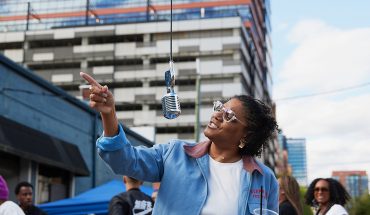How to lead change:
Larry’s Rules
by Larry Wheeler
photograph by Corey Lowenstein/News Observer
Raleigh is a big-time city, funky and sophisticated. You can feel the creative energy pushing us forward and inviting more smart, cool people into our midst. When I became the director of the North Carolina Museum of Art more than 23 years ago, Raleigh was not so high spirited. It was, however, a great place to live – as acknowledged by rating agencies worldwide. Great universities, first-rate museums, superb cultural amenities. And good people. Now here in the early decades of the 21st century, Raleigh and its defining cultural institutions are redefining themselves in light of growth, of course, and changing cultural values. How do we remain relevant together? New audiences have emerged – from many different backgrounds. How do we inspire them through new artistic voices and engaging experiences? How does our art reflect the dynamism of our city? What are our gathering places?
When I first arrived at the NCMA, the museum sat beside a prison for youthful offenders, the Polk Youth Center. Not so welcoming to the community. The new museum, which opened on Blue Ridge Road in 1983, was not so welcoming either. A late-modernist building designed by Edward Durell Stone, the original plan was greatly reduced in size because of the spiraling inflation at the time and a protracted civic lawsuit to keep the art museum in downtown Raleigh. A biggish building on a lot of land hemmed in by a prison and busy traffic thoroughfares diminished its “curb appeal” to the world outside. And yes, also hid the fact there was a world-class collection of art inside.
Now the NCMA has become a center of cultural life for Raleigh and the region. Sporting a 164-acre art park, a performance and film amphitheater, blockbuster exhibitions, award-winning architecture and landscaping, hospitable spaces to enjoy art and each other, and everywhere chances to learn.
I am often asked to lecture to MBA, law, and arts management students around the U.S. How to lead change is the big topic, and the NCMA’s evolution is the material evidence. After doing several of these presentations, I began to organize my thoughts and images around what I have come to think of as my Larry Rules, a set of principles that have guided our vision and success and are informed by inspiring leadership models in our community. So I thought it might be nice to share them with you.
Larry’s rules
“Enlarge the Picture” is Rule No. 1. Take a look around. What does the organization do well? Can it do more? Can it be made more relevant to the community and to people’s lives? What is the path to growth? What is the appropriate – but essential – degree of risk?
Our risk-taking was driven by our belief that Raleigh was ready for blockbuster exhibitions tied to well-known artists and art. They are expensive and complicated to produce, of course. Which is why folks go to New York, Washington, and other big cities to see them. But we enlarged our picture. And sure enough, crowds soared for Rodin, Matisse and Picasso, Monet, Rembrandt, Norman Rockwell, Escher, and Leonardo’s Codex Leicester. The exhibitions funded by sponsorships and ticket sales were financial successes. People discovered the NCMA from all over the world – and from right here in Raleigh. It became clear that we needed to grow in order to support our growing programs and audience.
Therefore, Rule No. 2: “Big Money Follows Big Ideas.” As hundreds of thousands of people discovered the NCMA from everywhere, it became clear that we were not big enough physically to support our growing program, audience, and collection. In 1983, the Edward Durell Stone building had accommodated the entire museum. But by 2000, it was clear that creating more space for expanding education activities, those big exhibitions, and public activities was essential.
And so we planned. We interviewed the leading architects in the world to present their ideas for a bigger museum, and ultimately hired Thomas Phifer and Partners in New York, a young firm with brilliant minds, to design our museum of the future. The price hovered between $50 and $100 million. Where would the money come from? We believed that an exciting architectural vision of international power would excite community leadership and donors. It did. Donors began to commit. And the aggregate commitment by the State of North Carolina and Wake County of more than $85 million made possible the award-winning building that opened in 2010.
Which brings us to Rule No. 3: “Politics Is Usual.” Ugh, you say. But think about it. Building support for your mission and program is something you do as a leader every day. Developing staff consensus and engaging board support are as much political activities as enlisting powerful voices in whatever governmental framework your organization functions. Getting good people elected (those who support your program) is an important activity. I have found that board members and community advocates are happy to link your cause to their support of candidates. It is a sophisticated and organic process.
The expansion of the NCMA, whether building new buildings or adding parkland, has depended on government investment, most often very large investment. To have the support of governors, mayors, council members, commissioners, heads of appropriations committees, and the president pro tempore of the senate and speaker of the house is critical. Taking the time to get to know these folks will enable a personal connection to your great cause. Use your most effective board members and be persistent and passionate in communicating your value and relevance to social and economic good. Timing is magic – and remember that “Big Money Follows Big Ideas.”
“If It Ain’t Broke, Fix It” is Rule No. 4. In other words, keep your reality real. No organization is ever perfect. Over time things get out of kilter, the community changes, board leadership comes and goes, staff dynamics shift. It is important every now and again to stop and take stock. Is your programming fresh and relevant? Is your communications technology up-to-date and effective? Are you competitive with the best programs in your field? Are you engaging new community leadership?
It is helpful on an annual basis to evaluate your plan with staff and board and agree on timely fixes. Reallocation of resources or even a little extra fundraising for “modernization” may help the fix. Always lead and be on it. And always be identifying and cultivating future leadership.
There are other Larry Rules, of course, but I will save the best for last. Really important, is Rule No. 5: “Listen.” Listen inside. Listen outside. Listen all the time. Also, I encourage young leaders to “Express Yourself.” Your personality and colorful attributes help define your organization to the community. Go wild – a little bit. And, another rule, “Be Important.” Recognition that comes to you as a leader is shared by all those you lead – staff, boards, the entire organization. So take those awards proudly. “Take Appropriate Risk,” is another good rule; so is “Partner Up.” It is important to forge alliances with like-minded organizations, with civic marketers, corporate sponsors, and on and on. But partners need attention. Manage them well.
All this brings us to my favorite rule: “Celebrate!” Yes. Parties are really good things if they are really good. They bring your community around you to dance, dine, and drink some wine. So celebrate your staff achievements. Celebrate your board and patron achievements. Celebrate the community you serve. And if celebrations bring some much-needed revenue, all the better. Celebrations scream success. And they raise the curtain on the next stage of success. So don’t hold back. Be creative, break the rules, and release the hidden human spirit. Make celebration a hallmark of who you are in the world.
Although I illustrate these points in academic lectures, I do not intend to lecture here. We are all in this together. So let’s work together to build a more exciting Raleigh.




